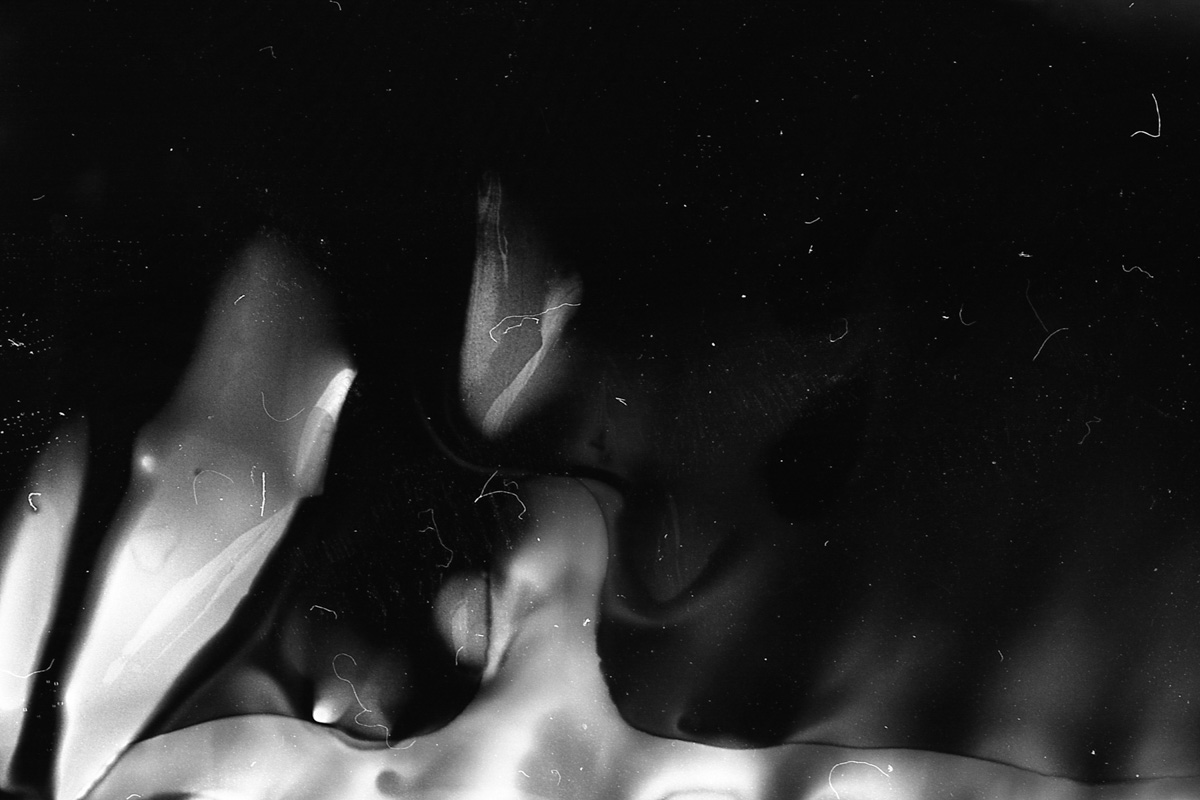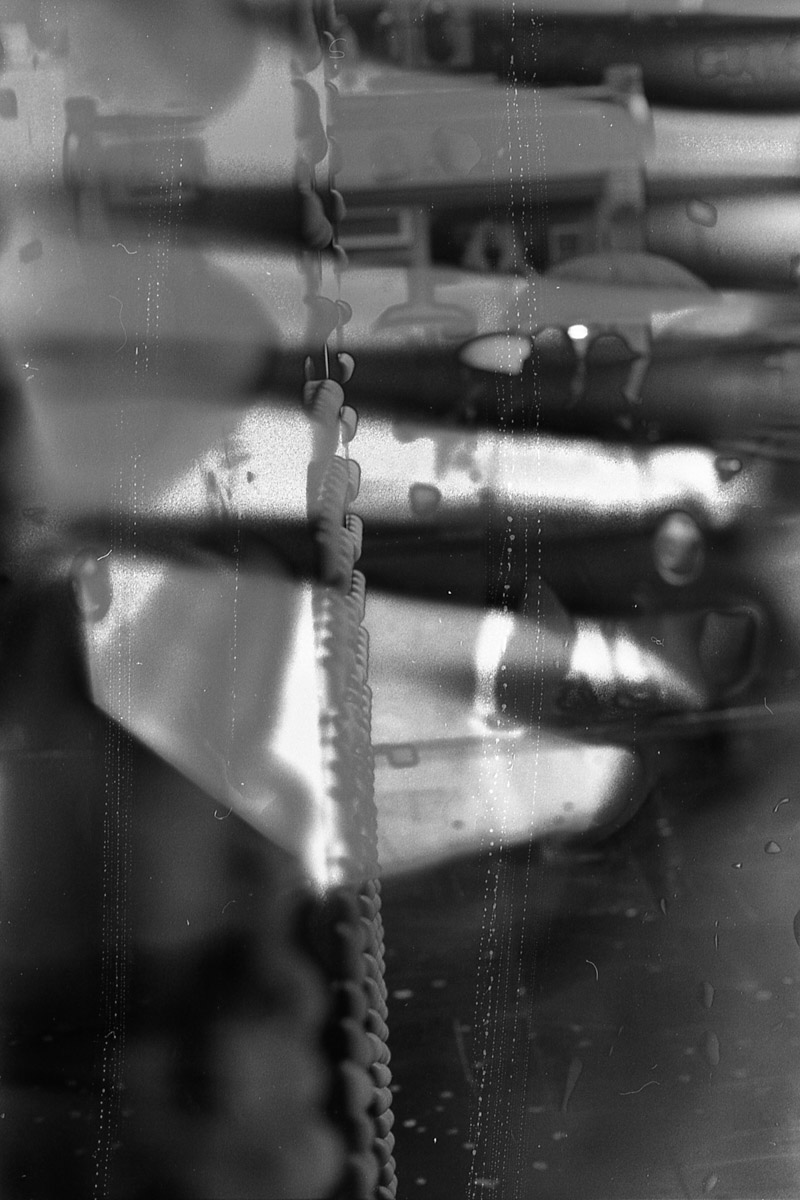I’m going to push the definition of this series but bear with me. First, I’d like to say that this was a disaster but also a learning experience. Like all good stories, this one has a bit of a background to it so let’s start with the question, why get into self-developing film at all?
In my case, it was also because of a disaster (a recurring theme, perhaps?). Way back in April of 2018 I had done a photoshoot with a model who had come over from the States. For most of the shoot I had used my digital camera. But near the end, I took out the old faithful Nikon F2 and shot a roll of black-and-white film.

A couple of days after the shoot I decided to send the film off to the wonderful folk at ILFORD (Harman Lab) to get it developed. I had used them a couple of times before and knew I could trust them. Selecting a brand-new plain paper envelope (see the mistake there?), I sent it off in the post.
“Thanks very much for the envelope here’s your money back”, said ILFORD a few days later. Yes, the envelope had ripped, and the canister had gone missing. Vowing never to do such a silly thing again, I thought I would try to develop my own film.I bought all the gear, selecting a two-reel Paterson developing tank and some ILFORD chemicals. Next, the fun bit, shooting. Into London I headed with a roll of Kodak T-MAX 100. On my return home I had to stop myself from developing the film straight away. I lasted about an hour.
Using the changing bag for the first time was fiddly, but I got the film out and onto the reel. Now, I had watched some videos saying that to keep the reel with the film in place inside the tank, it’s best to load the empty reel on top as well. Which is why I had both reels in the bag at the same time. See if you can guess where I went wrong…
I placed both reels onto the centre column, the empty one at the bottom and the full one at the top. Then enough developer for one roll of film. And so, the only time the film got developer was during the 10-second recommended agitation periods each minute.








































It should have been a great start to self-developing. It wasn’t. It was painful pulling that freshly developed roll of film out of the tank and seeing the blotchy results. I could have stopped there but I realised my mistake as soon as I pulled the film out and knew I had to try again.
I love to develop film at home, seeing the film as it comes out and hanging it up to dry is a little bit exciting. Did all my hard work framing and getting the exposure right, pay off? I’ve already learned that a good negative doesn’t necessarily make a good positive.
And in the intervening couple of years I’ve made more mistakes and learned more things. For example, if it was easy, we’d have all got bored with it and given it up for something else. One day I want to try my hand at printing. Let’s hope I have a better result.
~ James
Want to share your first roll or sheet of film?
Poorly exposed, badly framed and blurry photos? No-one is perfect, especially when shooting their first roll of film…but that’s ok and I’d like to spread that message. Submit as many frames from your first roll as you’re able to with an accompanying text of at least 500 words using this Google form. If you would prefer to submit another way, please use the contact link at the top of the page.
Share your knowledge, story or project
The transfer of knowledge across the film photography community is the heart of EMULSIVE. You can add your support by contributing your thoughts, work, experiences and ideas to inspire the hundreds of thousands of people who read these pages each month. Check out the submission guide here.
If you like what you’re reading you can also help this passion project by heading over to the EMULSIVE Patreon page and contributing as little as a dollar a month. There’s also print and apparel over at Society 6, currently showcasing over two dozen t-shirt designs and over a dozen unique photographs available for purchase.








16 responses to “My First Roll… Of self-developed black and white film (Kodak T-Max 100, Nikon F2)”
I never thought of it like that! I’m glad you can see the dancer at Piccadilly Circus through all that muck. Considering some of the other mistakes I have made, yeah I think I got off lightly 🙂
I think those negs are pretty awesome! Like you shot the inside of a volcano. Or maybe a very troubled sinus cavity! And the partial ones are even more interesting with people walking through this cool funk. One guy looks like he just climbed up the stairs from the inferno. The dancer in front of Boots is surreal. And in the midst of this psychedelic monochrome madness, a beautiful woman preens as though unaware of the stares from behind her. And lots of umbrellas – must be the UK! I think it’s quite a memorable first roll. The film gods were kind and let you off with at worst a joke and quite possibly something really cool. Thanks for sharing! Really enjoyed seeing your work.
I’m so glad you had a great laugh, that was how it was intended to be :). Yeah, all in one roll. I’m sure someone somewhere will think they are the best photos in the world. Personally it’ll take me a little longer to like them 😉
Been there and done that with the film on the top reel. Starting out, I suggest using Diafine with black and white film. It is highly tolerant to temperature deviation. Another easy route is semi-stand development. I have used Rodinal and HC 110. Next roll will be better, guaranteed.
Thanks for a really good laugh. These are priceless. Astonishing effects, really, and all in one roll? Truly impressive.
And yes, I’ve screwed up a fair few over the last .. umm .. 45 years I’ve been souping film.
Well, in any case that did produce some interesting effects. I messed up my fair share of rolls in various ways, but that never produced anything even remotely interesting.
Hi James,
Thanks for the article. I’ve developed B&W films for 50 years. Here are some of my greatest hits:
1. Loading a Patterson reel set to medium format with the film & backing paper. It was really hard loading that (1975)
2. Pouring in fixer first (early in my ‘career’)
3. Developing unexposed film.
4. Mixing B&W film & color neg. film and processing in B&W chemistry
5. Not pushing the reel all the way down on the center stem of a single reel Patterson tank.
6. Loading film emulsion side out.
7a. Forgetting to pour fixer in the tank & removing the cover after the ‘fixing’ time was up.
7b. Washing the film in hot water (emulsion sluffed off.)
8. Dropping freshly washed film after removing it from the reel on the floor.
9. Forgetting to put the reels on the stem and developing the film.
10. Developing the film and washing in too cold water (cracked emulsion.)
In my defense, I claim influences of Jack Daniels, various “medications,” and a couple of distracting girlfriends during the film processing session. Now, as I approach 70, my medications are DR. prescribed, happily married for 40 years, and JD is an after dinner drink. Still developing film and having fun!
Goodness me that’s quite a collection! I’ve definitely done number 8. I’ve sort of done 7a. When pouring out the developer everything fell out as I hadn’t locked it properly! Finally, I have used single shot developer, twice. That’s a very bad idea. Great if you want blank film, and I mean completely blank, including the frame markings.
Blank film is a statement! 🙄
Your defence is accepted! Darkroom work can be quite boring, and the time seemed to go quicker when alcohol gets involved. Popping out of the darkroom for some “medications” also helped the time pass in a more interesting way. Neither measure helped the accuracy improve, although it seemed less of a problem… until the next morning!
PS: This thread gives me incredible gear envy (not normally my thing at all), but that is one damned good-looking F2! So like the F2Sb I reluctantly sold in 1988/9 – it is still one of my favourites.
I also have a point 11 (as a combined result of all three of your defences) that is going to bed while the film is washing with a force washer (10 mins is enough), and coming back to the darkroom almost 24 hours later to find that the washing has been so effective that it has washed all of the emulsion off the base, which is now completely clear.
No! That’s just awful!
Paterson tanks should come with a locking collar to stop the spiral sliding on the cemter column. Needless to say, many have gone astray on second hand tanks! But it does save getting a second spiral wet unnecessarily.
My early Patterson System 4 tanks with screw-on lids came with white plastic C-shaped clips that you could slide onto the column to keep the spiral in place. None of the later “big-mouth” bayonet lid tanks I bought ever came with one.
They sort-of worked… for a while. The trouble was that they lost their grip and eventually became too loose to do any good. If you left them on the colum while the tank was not being used, even for just a few days, they would loose much of their springy grip.
It’s great to see mistakes shared! Kudos to you…
Thank you very much 🙂 I wanted to show people that everyone makes mistakes even when you know what you’re doing!